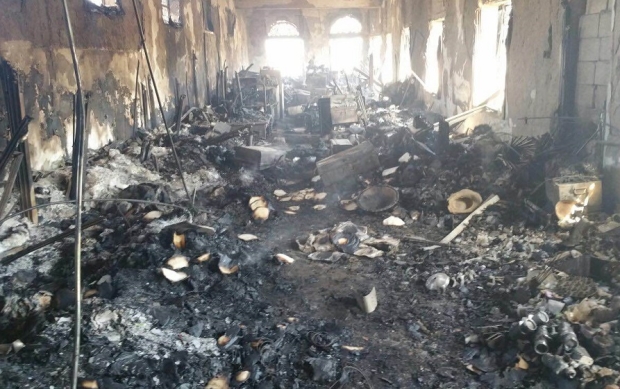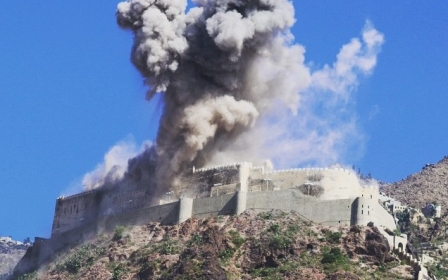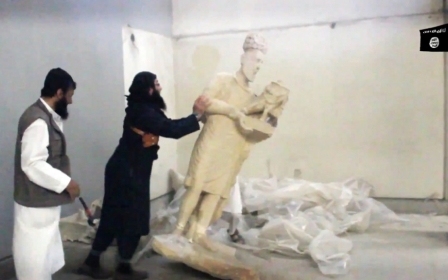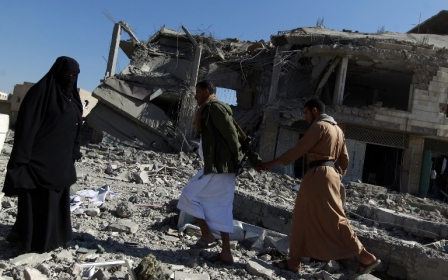Taiz national museum reduced to ash by fighting

TAIZ, Yemen – Heavy Houthi shelling in recent days has sparked a fire in Taiz’s national museum, burning the building and the vast majority of its historical treasures to the ground.
Manuscripts, an ornate turban said to belong to an unknown but ancient king, old Qurans dating back more than 1,000 years, and private pistols of Imam Ahmed Hamid Al-Deen - the last Yemeni Imam (national religious leader) before Arab nationalists seized power in 1962 - have all been destroyed, local Popular Resistance fighters who oppose the Houthis told MEE.
A day after the flames had subsided, MEE was able to visit the site. Small silver objects could be seen peeking out from amidst the layers of thick ash. The charred remains of manuscripts with blackened edges lay sprinkled above the now totally unrecognisable remains of relics.
The heavy fighting and shelling resumed in late January when the Houthi fighters once again began targeting the museum of Taiz that is controlled by the resistance.
The Houthis targeted the museum for the first time in October 2015, when the resistance took over it, and despite the museum catching fire, only a portion of the building was damaged.
New MEE newsletter: Jerusalem Dispatch
Sign up to get the latest insights and analysis on Israel-Palestine, alongside Turkey Unpacked and other MEE newsletters
"On 30 January, the Houthis targeted the museum from Al-Salal hill, east of Taiz city, and after heavy shelling by more than five rockets the museum burnt down," Moaath al-Yaseri, a leader of the Popular Resistance in Taiz, told MEE.
Yaseri accused the Houthis of trying to destroy the historical places and artefacts of Yemen’s long and colourful history, saying that the Houthis did not know about the cultural significance of these things.
Taiz was Yemen’s capital from 1175 until falling to Ottoman armies in 1516. Sanaa would only be declared the capital in 1962.
The museum was built by Imam Ahmed and acted as his palace before the nationalist revolution of 1962. It was then converted to a museum and contained almost all the historical pieces of Taiz province.
"When I entered the museum, I found the old manuscripts and the historical pieces reduced to ash,” Yaseri said, confirming that the Houthis were still targeting the museum even after it had burnt down.
While the Popular Resistance in Taiz accused the Houthis of burning the national museum, the Houthis said that the resistance had been using the museum as a military base from which to shell them.
"AnsarAllah [the Houthis] do not have any interest in burning the museum, but the resistance is responsible for burning the museum as the fighters of the resistance targeted the Houthis from the museum," a Houthi leader originally from Taiz city told MEE on condition of anonymity.
"Most of the Houthi fighters are originally from Taiz province, and the history of Taiz is their history, and no one wants to destroy his history himself."
Regardless of who is to blame though, the reality is that Yemen’s historical sites are being ravaged by the fighting.
Last year, Cairo Castle (also known as Qahira castle), which has towered over Taiz in some form for almost 3,000 years, was shelled and partially destroyed. Once again, most of the reports from the ground blamed the Houthis, although the group denied this and said that the resistance had instead chosen to target them at positions in the castle, and said that they had been bombed by the Saudi-led coalition.
The capital Sanaa - parts of the UNESCO-protected site date back more than 2,500 years - has also been devastated, this time largely by Saudi-led, anti-Houthi coalition bombing.
UNESCO director general Irina Bokova said back in June that she was "profoundly distressed by the loss of human lives as well as by the damage inflicted on one of the world's oldest jewels of Islamic urban landscape".
Mamoon Mohammed, a history professor at Taiz University, has called on both sides to stop fighting near places of historical significance and to make steps to protect the country’s heritage.
"The resistance made the mistake of putting their military vehicles in the museum, but this is not enough of an excuse for the Houthis to target the museum - so both sides are responsible for its destruction," Mohammed said.
"By targeting the historical places, the warring sides are going to kill our history, and that is why I am calling [on] the warring sides to refrain from fighting in Yemen’s historical places," he said.
Blame game continues
Meanwhile, as Yemen’s heritage burns, the two sides are continuing to play the blame game and refusing to lay down their weapons.
Since last April the museum has been passed back and forth. The Houthis took it over in April 2015 shortly after sweeping south from Sanaa and seizing much of Yemen in a blitzkrieg assault.
However, in October their grip loosened and the museum was secured by the resistance, with the Houthis saying that the coalition had pounded the museum from the sky, although the coalition and its allies deny this.
According to residential accounts, the resistance then started using the museum as a base, parking its military vehicles there. Several residents said that they never heard any shots being fired from the museum and said that until recently they had largely felt safe.
Moqbel Sharaf, 29, a resident in the museum neighbourhood, told MEE that the area was safer than others as there had been no clashes, with only vehicles belonging to the resistance spotted moving in that area of town.
"I saw the vehicles of the resistance enter and leave the yard, but the resistance did not fire on the Houthis from our neighbourhood,” Sharaf said. “But the Houthis started to target the museum four days ago and they still have not stopped.”
The few residents who had stayed on were then finally forced to leave. Sharaf is one of the few tp stay behind, and has been forced to hide out in basements with a handful of other stragglers destined to watch from the sidelines as their city’s ancient heritage goes up in flames around them.
Middle East Eye delivers independent and unrivalled coverage and analysis of the Middle East, North Africa and beyond. To learn more about republishing this content and the associated fees, please fill out this form. More about MEE can be found here.





